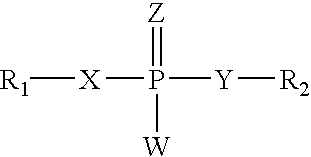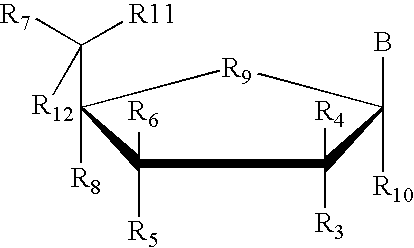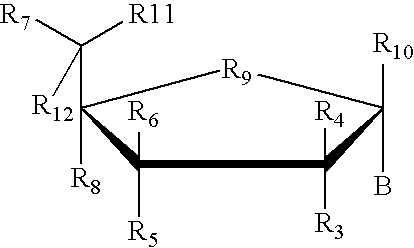Transcription factor RNA interference reagents and methods of use thereof
a transcription factor and interference technology, applied in the field of methods and reagents, can solve the problems of inability to assay interference activities, kreutzer et al. similarly fails to provide examples or guidance as to the extent of these modifications, and cannot be successfully adopted in vivo
- Summary
- Abstract
- Description
- Claims
- Application Information
AI Technical Summary
Benefits of technology
Problems solved by technology
Method used
Image
Examples
example 2
Method of Transfecting Cultured Cells with the RNAi Reagents of the Present Invention
RNAi transfection
[0258] RNAi transfection was done in 96 well plate. Briefly, Hela cell (ATCC) were seeded the day before the transfection at 26,000 cell / well in 125 ul of MEM *media plus 10% of FBS. Before transfection, a dilution of the Lipofectamine™ 2000 (INVITROGEN) was prepared. From the stock tube, a 1:25 dilution in Opti-MEM was made. The mixture was allowed to stand at room temperature for about 15 minutes. At the same time, a dilution of the siRNA duplexes from the 20 uM stock tube was prepared. The dilution was further diluted in Opti-MEM to make a final concentration of 240 nM. After the lipid was diluted for 15 minutes, equal volumes of the diluted lipid and the diluted siRNA duplexes were mixed together and incubated at room temperature for 20 minutes to allow the siRNA and the lipid to form complexes. Then, 25 μl of the mixed solution was added to the appropriate wells, pipetted up ...
example 3
Method of Measuring the Effect of Transfecting Cultured Cells with the RNAi Reagents of the Present Invention on the Transcript Levels of each Target mRNA
mRNA Isolation
[0259] mRNA was isolated according to the manufacturers instructions for the mRNA Catcher™ Protocol from SEQUITUR (Natick, Mass.).
cDNA Synthesis
[0260] cDNA synthesis was performed by using a modified procedure outlined in the ABI TaqMan reverse transcription kit, No. N808-0234 from Applied Biosystems, Inc. (Foster City, Calif.). Briefly, the modified method was as follows: 19.25 ul of mRNA solution was used for cDNA synthesis. The reaction was performed in an ABI thermal cycler 9600 with one cycle as follows: 25° C., 10 min; 48° C., 40 min; and 95° C. for 5 min. The cDNA was keep at −20° C. until use.
Quantitative RT-PCR
[0261] Oligonucleotide primers and TaqMan® probes for the E2F1, CREB, NFkB-p65, and CDC2A genes for the quantitative PCR experiments were purchased from Taqman® Assays-on-Demand™ Gene Expression P...
example 4
Method of Assessing the Effect of Transfecting Cultured Cells with RNAi Reagents Directed Against the E2F1 Receptor on E2F1 Transcript Levels Using RT-PCR
[0263] The level of human E2F1 transcription factor 1 (E2F1; Genbank Accession No. NM—005225) transcript in HeLa cells subsequent to transfection with E2F1-specific RNAi reagents was assessed using RT-PCR. HeLa cells were transfected with one of four E2F1-specific RNAi reagents according to the method outlined in Example 2 herein. The sequence of the plus and minus strand of each double-stranded E2F1-specific RNAi reagent is provided in Table 1 below. The intended target sequence within the E2F1 transcript is also provided for each RNAi reagent.
[0264] RT-PCR was performed as outlined in Example 3. The E2F1 receptor-specific TaqMan primer set was obtained from Applied Biosystems (Foster City, Calif.) as an Assays-on-Demand(TM) Gene Expression Product (Assay ID No. Hs00153451_m1). The Assays-on-Demand(TM) Gene Expression Product fo...
PUM
| Property | Measurement | Unit |
|---|---|---|
| pH | aaaaa | aaaaa |
| Tm | aaaaa | aaaaa |
| volume | aaaaa | aaaaa |
Abstract
Description
Claims
Application Information
 Login to View More
Login to View More - R&D
- Intellectual Property
- Life Sciences
- Materials
- Tech Scout
- Unparalleled Data Quality
- Higher Quality Content
- 60% Fewer Hallucinations
Browse by: Latest US Patents, China's latest patents, Technical Efficacy Thesaurus, Application Domain, Technology Topic, Popular Technical Reports.
© 2025 PatSnap. All rights reserved.Legal|Privacy policy|Modern Slavery Act Transparency Statement|Sitemap|About US| Contact US: help@patsnap.com



